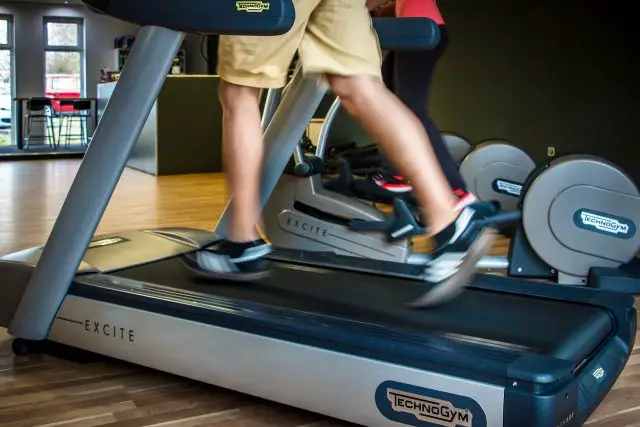During the 2016 Summer Olympics in Brazil, Jamaican sprinter Usain Bolt defended his title as the world’s fastest man and won his 4th Olympic gold medal, and is in the 100 top paid athletes in the world today. While most people are unable to run at speeds anywhere close to Bolt’s top speed, there are a variety of different health benefits associated with getting off the couch and going for a run.

Usain Bolt with his gold medal at the Rio Summer Olympics, 2016. Picture: Fernando Frazão/Agência Brasil
Benefits of Running Daily
- Running Can Help You Drop Weight and Lose Belly Fat
- Running Keeps Your Mind Healthy and Promotes a Good Mood
- Running Helps You Sleep Well
- Running Keeps Your Cardiovascular System Strong
- Running is Easy to Learn
- Running Decreases Risk of Various Types of Cancer
In the United States today, millions of adults and children are considered overweight or obese, which can lead to a host of different health problems.
Running is one of the most effective ways to lose weight, as it burns more calories than walking and many other types of exercises. Additionally, high-intensity exercises, such as running, lead the body to burn a higher than normal amount of calories even after the exercise is over, in what is called ‘afterburn’.
Running is also a fantastic way to lower the amount of belly fat. It is suggested that men keep their waist circumference less than 40 inches and women maintain a circumference of less than 35 inches. Running interval workouts helps to tone the core and burn away excess fat from the waistline.

Running can help you loose belly fat
Every single year, millions of Americans are diagnosed with age related cognitive impairments, such as Alzheimer’s and dementia. While treatment and prevention of these diseases vary from person to person, it has been suggested that those who are suffering from mild to moderate Alzheimer’s may find relief from accompanying depression and may even help slow down the progression of the disease.
Cardiovascular exercises, including running, can also help to protect the pathways in the brain that are affected by Alzheimer’s disease, effectively helping to lower the risk of development of this disease.
Running at a challenging, yet manageable pace, also releases endorphins into the bloodstream, a natural response to pain. This pain response is also known as a runner’s high, which helps runners push through a long race. While new runners may not experience a runner’s high, running can definitely help to reduce stress and anxiety.
One in three Americans will suffer from at least a mild form of insomnia at some point in their lives.
Running has been shown, over time, to help improve the quality and length of sleep. For many participants in the study, it took up to 16 weeks to see improvement, so while it may take awhile to see tangible results, sticking with running will help you feel healthy and well rested in the long term.
For people without chronic insomnia, running is a good way to burn of excess energy so by the end of the day you can fall asleep quickly and sleep soundly.

Running helps you sleep well
The cardiovascular system can be impacted by a host of different ailments. This includes high blood pressure, high bad cholesterol, and heart disease, all of which can lead to an increased risk of heart attack and stroke.
Running plays a significant role in keeping the cardiovascular system healthy. Running helps reduce inflammation in the arteries, which can help to reduce high blood pressure. Running also can reduce high cholesterol by keeping the arteries flexible.

Running = healthy cardiovascular system
Unlike biking, swimming, cross country skiing, and many other types of exercises, running does not require a large investment in equipment.
Running requires a decent pair of sunning shoes and comfortable clothing and a little bit of patience.
For most people who are not in shape, it is not possible to start a training program and be able to run three miles right off the bat. Start with intervals of running and walking until you are able to completely run one or two miles, and increase the distance from there.
Cancer is one of the scariest diagnoses a doctor can give you, and over one million children and adults in the United States receive this terrifying news every single year.
There are a host of different causes of cancer, but running may help to reduce the risk of certain types, including breast, colon, endometrial, lung, and prostate cancer.
Running can also be a way to help overcome and prevent some of the symptoms associated with cancer treatments such as radiation and chemotherapy.
Difference Between Running Outside Versus on a Treadmill
Running on a treadmill can feel completely different than running on the sidewalk, road, or trail. Many runners find they prefer one over the other, but there are some definitely benefits to running on a treadmill that cannot be found outside.

There are many benefits of running on a treadmill
- Treadmill Running Can Help Improve Your Form
- Treadmill Running Can Keep You Safe
- Treadmill Running Can Help You Control Your Run
When running, it is important to keep good form to help avoid knee, hip, and back injuries. While running on the treadmill, it is easier to take a video of or have a friend critique your form and help you correct any problem areas.
While there are multiple benefits of running outside, unfortunately, running outside comes with some inherent risks.
While pedestrians should hopefully be safe on sidewalks and the side of the road, many runners every year experience scares, injuries or are even killed as a result of drivers not paying attention.
Additionally, running in unfamiliar neighborhoods or at night can increase the risk of getting lost, or worse, getting attacked or robbed. Furthermore, if you are injured while running outside you are left vulnerable and unable to get home until someone is able to come and help find you.
Running on a treadmill helps to alleviate some of these concerns. You can run on the treadmill early in the morning or late at night, or when the weather makes it unsafe to be outside. In the worst case scenario of being injured while running, you will be at home or at a gym and can easily sit down to ice an injury or call for help if necessary.
Running on a treadmill offers a more versatile workout plan. Many treadmills offer various workouts, allowing you to do a hill workout in an area that doesn’t have hills. It also can time your interval training for you, so you don’t have to worry about bringing a stopwatch.
Benefits of Running in the Morning
- You Can’t Make Excuses Not To Run After A Long Day
- A Morning Run Can Help Lower Blood Pressure
- Running in the Morning May Help Emotional Health Even More
For many people, it is easy to make excuses after a long day at work or school as to why they don’t have time to go for a run. Planning a run in the morning takes away these excuses and ensures that you get your exercise in.
Running is a great way to lower blood pressure, but there is evidence that running in the morning may be better for lowering high blood pressure than running later in the day.
This may be particularly important in preventing heart attacks, according to new research. Researchers believe that upon waking, hormone levels increase, which is why heart attacks are most common in the morning. Researchers are hopeful that running in the morning, and therefore lowering blood pressure throughout the entire day, may help reduce heart attacks.
For many people who are suffering from depression, getting out of bed in the morning, particularly to go out for a run, can seem particularly daunting.
However, those who have been diagnosed with depression or other mental illnesses may see drastic reduction in feelings of sadness, hopelessness, and worthlessness when getting out for an early morning run.
Running is a form of meditation, forcing you to block out distractions and focus on your breathing. Those endorphins that regular runners enjoy also help those suffering from mental illness to recover from pervasive negative thoughts and feelings.

Many people prefer running in the morning because of its many benefits
Who Should Avoid Running
Running can be incredibly beneficial for almost everyone, but there are some people who should avoid running for the risks that it can play on the heart.
Those who have very high blood pressure, very high cholesterol, or have had a heart attack in the past 6 months should avoid vigorous exercise for the risk that running plays on heart attack and death for those not healthy enough.
For those who are suffering from arthritis or other joint concerns should be mindful of running as to not exacerbate any conditions. If you are unsure if you are healthy enough for vigorous exercise, talk with your healthcare provider.
Conclusion
Every single year, Americans shell out millions of dollars on gym membership and exercise classes.
However, one of the most beneficial ways to get into shape requires no gym or expensive equipment investment, can be done by almost everyone, and has a wide variety of different health benefits associated with it. Whether you are a novice or seasoned runner, lace up your shoes and enjoy the open road.






